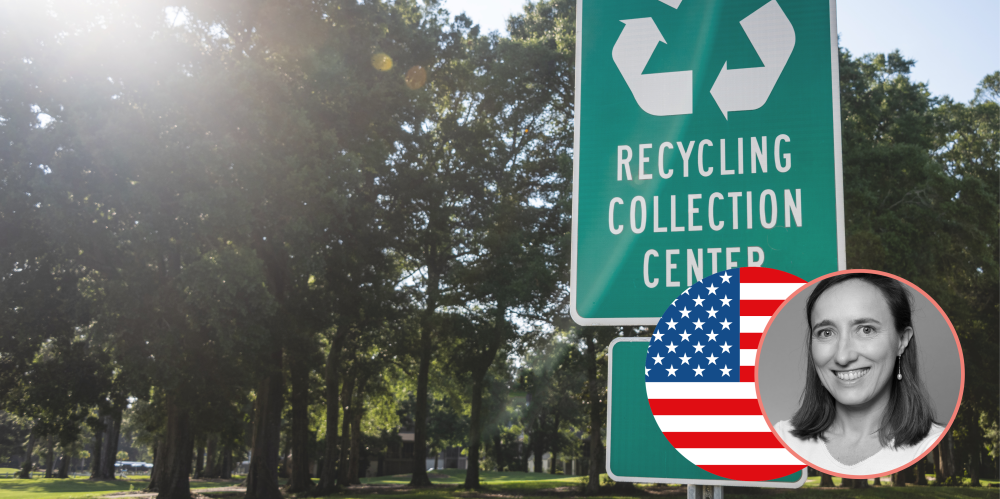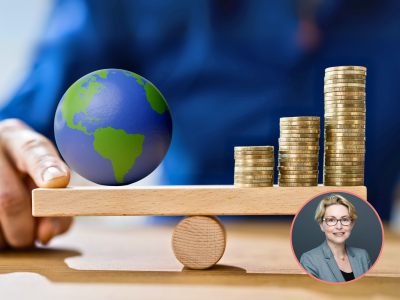Circular economy from a US perspective: towards transatlantic convergence? (2/2)

Photo Canva x Alice C.
Without national legal standards on recycling, circular economy is developing through local initiatives. There is significant heterogeneity among states and a lack of information among citizens on the subject. European regulations could have a significant impact on the growth of circularity in American businesses.
The American circular enablers: local anchorage in the absence of a federal compass
At the federal level, the US is not among the 49 countries that launched national circular economy roadmaps. It appears as a latecomer compared to the other OCDE countries, and notably EU which adopted a Circular Economy Action Plan in 2020, then boosted by the Green Deal “NextGeneration EU Recovery Plan” in 2022.
Moreover, circular economy often remains a flexible concept (not to say fuzzy) in the American national rhetoric, obviously more focused on waste management downstream issues rather than design upstream issues - whereas 80% of products’ environmental impacts are determined at the design phase. However, the lack of federal policy emphasis doesn’t mean the absence of governmental guidelines at the local level, be it states or cities.
Recycling is an example of the drawbacks of decentralized US regulation. As no national labeling standard exists, most recycling norms are state-determined. This heterogeneity generates confusion both for manufacturers and consumers - all the more so far as recycling processes and facilities also vary greatly depending on locations. It leads to the phenomenon of “wish-cycling”, which is the well-intentioned but unfounded belief that something is recyclable when it is not. Indeed, 59% of Americans believe “most types of items” can be recycled and their miscellaneous recyclables are efficiently sorted[1], whereas in reality wish-cycling contaminates the recycling system. Moreover, the lack of recycling legal standards facilitates corporate “recycle-washing”. In 2021, a lawsuit against TerraCycle and 8 major companies revealed misleading claims and led the accused companies to change their labels. According to the charging party, the US was “the wild, wild west of product packaging labels and claims with no sheriff in town. ”[2]
American circular stakeholders: towards convergence with Europe?
After decades of local-based political leadership on the implementation of circular measures, a rebalancing has been occurring for a few years, through both voluntary and endured national drivers. The Inflation Reduction Act passed in August 2022, the most comprehensive climate legislation in the US so far, should boost the transition to a circular economy: by accelerating new circular markets domestically, facilitating environmental remediation, and financing circularity-enabling solutions[3].
In 2021-2022, the Federal administration also established several low-carbon product standards for Federal procurement, that may extend to ecodesign regulations in the whole industry. As for the Bipartisan Infrastructure Law passed in November 2021, it provided unprecedented funding to support state and local investment, notably in waste prevention, reuse, and recycling programs coordinated by the Environmental Protection Agency (EPA).
In addition, the EU’s Corporate Sustainability Reporting Directive (CSRD) will soon mandate reporting of wide-ranging ESG data to European as well as foreign companies with EU operations, including US-based[4]. It is worth noting that CSRD should hasten the shift from a linear to a circular economy also on the other side of the Atlantic. Indeed, the new European Sustainability Reporting Standard (ESRS) E5 introduces the first mandatory reporting on resource consumption, waste generation, circular design, and recovery of products and materials, encouraging companies to assess their circularity performance across the entire value chain.
Consequently, be it by choice or by force, the US is in the same boat as Europe regarding the circular economy “megatrend”, currently navigating towards a political and corporate transatlantic convergence…
[1] Perceptions and realities of recycling vary widely from place to place. Drew Desilver. Pew Research Center. October 7, 2016.
[2] Last Beach Cleanup: TerraCycle lawsuit exposes US as “Wild West” of “deceptive” product labeling. Packaging Insights. Louis Gore-Langton. August 31, 2021.
[3] How the Inflation Reduction Act Will Accelerate the Case for Investing in the Circular Economy in the United States. Ale Bryan. August 18, 2022.
[4] EU’s New ESG Reporting Rules Will Apply to Many US Issuers. Emma Bichet, Jack Eastwood, and Michael Mencher. Harvard Law School Forum on Corporate Governance. November 23, 2022.
Author : Alice C., People4Impact Expert
As a freelance writer and advisor, Alice Carré-Seemuller helps organizations committed to a more sober and resilient world to gain visibility and credibility. Her main areas of interest are circular & regenerative practices, soil health & sustainable food, climate change awareness & advocacy. After a 15-year experience as a senior civil servant in French local governments, she received a certification in Circular economics awarded by Harvard University.
To discover the first part of the article, click here.




